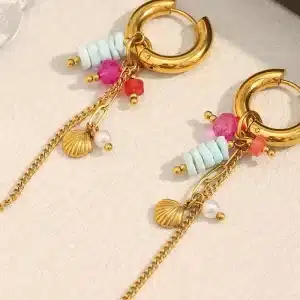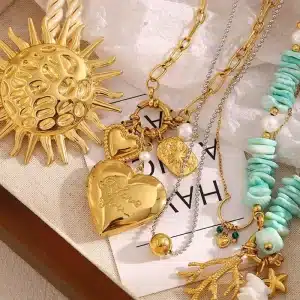Clean Copper Jewelry: Care & Maintenance Tips

Table of Contents
How to Clean Copper Jewelry: The Complete Care Guide
Copper jewelry has a warm reddish-orange luster that stands out from other metals. For centuries artisans have favored copper for its affordability, malleability, and traditional—though not medically proven—healing associations. Copper will tarnish and oxidize over time, so a little regular care keeps each piece looking its best. Read on for safe, practical ways to clean copper jewelry at home, tips for everyday care, and when to call a professional.
Understanding Copper Jewelry
The Rich History of Copper in Jewelry
Copper: Copper has long been valued as an affordable metal for attractive, wearable art — durable enough for everyday pieces yet soft enough for detailed work.
Copper has been used for jewelry making for thousands of years, with evidence of worked copper dating back to prehistoric times. The Ancient Egyptians were among the earliest civilizations to craft copper jewelry (circa 2,500 BC), and Native American cultures also used hammered and etched copper for pendants, bracelets, beads, and other decorative pieces that signified status and identity.
Why Copper Jewelry Is Special
The malleability of copper makes it perfect for creating elaborate, decorative jewelry. Its warm luster pairs especially well with semi-precious stones that have pink or red undertones, such as rose quartz, rhodochrosite, and garnet — common choices for copper pieces in modern designs.
Beyond looks, copper has been traditionally associated with health benefits. While these claims are part of folklore rather than medical fact, copper is an essential trace mineral in the body and is traditionally believed to:
- Support healthy blood circulation (traditional belief)
- Reduce inflammation and ease joint discomfort for some wearers (anecdotal)
- Contribute to the body’s processing of iron and formation of red blood cells
- Play a role in connective tissue and collagen production as a trace mineral
- Be appreciated culturally for symbolic or spiritual reasons
Why Copper Jewelry Tarnishes

Copper tarnishes faster than metals like gold or sterling silver because of a chemical process called oxidation. Over time copper reacts with oxygen, moisture (water), sweat, lotions, and the natural oils on your skin — all of which speed up tarnish and change the metal’s surface.
- Tarnish – a brownish or darkened film that dulls the metal’s original luster
- Patina – a greenish layer (think Statue of Liberty) that forms with long-term exposure to air and pollutants
- Green residue – the greenish stain that can transfer to skin after contact with untreated copper jewelry
Some collectors appreciate the aged look of a natural patina, but if you prefer the warm, reddish-orange shine of new copper, regular cleaning and proper care will keep your copper jewelry bright. (Chemically: copper + oxygen → copper oxide; prolonged exposure to air and carbonates can produce the greenish basic copper carbonate commonly called patina.)
Before You Clean: Things to Know
Is Your Copper Jewelry Coated?
Before you try any cleaning method, check whether your copper jewelry has a protective coating (clear lacquer, wax, or spray sealant). Many jewelry makers seal copper pieces to slow tarnish, prevent skin staining, and preserve the finish, and cleaning a sealed piece the wrong way can damage that coating.
How to determine whether your copper is sealed:
- If the piece has stayed the same color for a long time with only minor dulling, it’s likely sealed.
- Sealed copper usually doesn’t leave a green stain on the skin after wearing.
- The surface may feel smoother or slightly different from raw, uncoated copper.
If your piece is sealed, avoid abrasive cleaners and harsh acids. The safest way to clean a coated copper piece is with a soft cloth dampened with warm water and a drop of mild dish soap—wipe gently, rinse with clean water, and dry immediately to protect the sealant.
Is There a Gemstone in Your Copper Jewelry?
Gemstone-set copper jewelry needs gentler care because many stones are sensitive to acids, heat, or prolonged moisture. Acids like vinegar or lemon juice can damage porous or treated gems.
- Use only gentle cleaning methods for gem-set pieces.
- Avoid soaking gemstone jewelry in any solution; instead, wipe around stones with a soft, damp cloth.
- Be especially cautious with porous or delicate stones such as opal, turquoise, pearls, and some dyed or treated gems.
- When in doubt, check with the maker or a professional jeweler before attempting to clean a valuable or fragile piece.
Homemade Tips on How To Clean Copper Jewelry at Home
Method 1: Soap and Water (Safest Method)

Best for: Most copper jewelry — sealed or unsealed. For pieces with gemstones, use this method carefully (do not soak stones; wipe around them instead).
What you’ll need:
- Mild dish soap
- Warm water
- Soft microfiber cloth
- Optional: soft-bristled toothbrush for crevices
- Clean towel for drying
Steps:
- Mix a few drops of mild dish soap into a small bowl of warm water.
- Dampen the microfiber cloth in the solution and gently wipe the copper jewelry. For gem-set pieces, do not submerge — instead, dampen the cloth and clean around stones.
- Use a soft-bristled toothbrush only to reach dirt in tight crevices; brush gently to avoid scratching the metal or loosening settings.
- Rinse the piece quickly under clean running water (or wipe with a second damp cloth) to remove soap residue.
- Dry thoroughly with a soft towel, then allow the piece to air-dry fully before storing to prevent trapped moisture from accelerating tarnish.
This gentle soap-and-water method is the go-to way to clean copper jewelry without risking damage. It’s also the safest first step before trying stronger methods like lemon-and-salt or baking soda paste.
Method 2: Using Lemon and Salt Solution
Not best for: Gemstone-set or sealed copper pieces — acids and abrasives can damage some stones and finishes.
What you’ll need:
- 1 fresh lemon (or bottled lemon juice)
- 1–2 tablespoons table salt
- Small bowl
- Soft cloth
- Optional: soft-bristled toothbrush for crevices
- Clean water for rinsing
Steps:
- Squeeze lemon juice into a small bowl and stir in salt until it forms a coarse paste (or mix equal parts lemon juice and salt).
- Apply the paste gently to the tarnished areas with a soft cloth or cotton swab — avoid letting the paste sit on any gemstones or sealed surfaces.
- For detailed pieces, work the paste into crevices with a soft-bristled toothbrush, using light pressure.
- Rinse thoroughly under running water (or with a clean damp cloth) to remove all lemon and salt residue.
- Dry completely with a soft cloth and allow the piece to air-dry fully before storing.
The acid in lemon juice helps dissolve tarnish while the salt provides mild abrasion to lift it away — a reliable household way to restore shine on unsealed copper pieces when used carefully.
Method 3: Vinegar Solution

Best for: Heavily tarnished, unmounted copper pieces (do NOT use on gemstone-set or sealed items).
What you’ll need:
- White vinegar (distilled)
- Optional: 1–2 tablespoons kosher or table salt for extra cleaning power
- Small bowl
- Soft cloth or old toothbrush
- Clean water for rinsing
Steps:
- Pour enough white vinegar into a bowl to cover the copper piece.
- Optional: stir in 1–2 tablespoons of salt if the tarnish is heavy (salt increases the solution’s effectiveness).
- Soak the copper for about 10–20 minutes — check periodically; do not over-soak, and never soak items with gems or delicate finishes.
- Remove the piece and gently rub with a soft cloth or toothbrush to lift loosened tarnish.
- Rinse thoroughly with clean water and dry immediately with a soft cloth.
Method 4: Baking Soda Paste
Best for: Stubborn tarnish on unmounted, unsealed copper pieces (avoid on gemstones or plated pieces).
What you’ll need:
- 2–3 tablespoons baking soda
- Lemon juice or water to make a paste
- Small bowl
- Soft cloth or toothbrush
- Clean water for rinsing
Steps:
- Mix baking soda with enough lemon juice or water to form a thick paste.
- Apply the paste to tarnished areas and rub gently with a soft cloth or toothbrush.
- Rinse thoroughly to remove all paste, then wash briefly with mild soap and warm water if needed to remove residue.
- Dry fully with a soft cloth and allow the piece to air-dry before storing.
Step 5: Use Ketchup (Don’t Knock It Till You Try It)
Best for: Slight surface tarnish on unsealed copper pieces. This is an anecdotal household trick — use it sparingly.
What you’ll need:
- Plain tomato ketchup
- Small bowl
- Soft cloth or toothbrush
- Clean water for rinsing
Steps:
- Rub a thin layer of ketchup onto the tarnished metal or submerge the piece briefly in a small bowl of ketchup.
- Let it sit for 10–15 minutes, then gently scrub with a soft cloth or toothbrush.
- Rinse thoroughly with clean water and dry completely.
Because these methods cover a range from mild to aggressive, choose based on how delicate the piece is: start with soap and water, then move to lemon/salt or baking soda paste for tougher tarnish, and reserve vinegar or ketchup for unmounted, unsealed copper. Always rinse and dry well to prevent re-tarnishing.
Copper Jewelry Care: Preventing Tarnish
Daily Care Tips
- Remove before showering or swimming — chlorine, soaps, and shampoos accelerate tarnish by exposing copper to harsh chemicals and prolonged moisture.
- Wipe after every wear — use a soft cloth to remove oils, sweat, and lotions that speed oxidation; a quick wipe keeps your pieces looking bright.
- Apply cosmetics first — put on lotions, perfumes, and makeup before jewelry to reduce direct exposure to chemicals that can dull the finish.
- Store properly — keep copper jewelry in a cool, dry place, ideally in anti-tarnish pouches or a box with anti-tarnish paper; silica gel packs also help control moisture.
- Separate metals — store copper pieces apart from silver, gold, or plated items to avoid scratches and chemical reactions between metals.
Sealing Your Copper Jewelry

To lengthen the time between cleanings, consider sealing your copper pieces. Sealants reduce direct exposure to air, moisture, and skin oils, preserving shine and minimizing green skin marks.
Commercial Options:
- Renaissance wax — museum-grade wax often used to protect metal surfaces; durable but requires careful application.
- ProtectaClear — a spray lacquer designed for jewelry; provides a clear barrier but will wear over time and may need reapplication.
- Clear nail polish — a quick, low-cost option for small contact areas; note it can yellow and chip and is not as durable as professional products.
Application:
- Clean and dry the item thoroughly before sealing — any residue trapped under a sealant will continue to promote tarnish.
- Apply a thin, even layer of the chosen sealant following the manufacturer’s instructions.
- Allow the piece to dry and cure completely before wearing; drying times vary by product.
- Reapply as needed — for rings and bracelets that get a lot of wear, expect to reseal every few months; for necklaces or occasional-wear items, once or twice a year may suffice.
Sealing is a practical household option when you want low-maintenance copper pieces. If you prefer a natural patina, skip sealing and use selective cleaning (see cleaning methods above) to preserve desired tones while touching up high points for shine.
When to Call in a Professional Cleaning Service
Most copper jewelry can be cleaned safely at home, but you should seek a professional when a piece is valuable, fragile, or complex.
- Rare or collectible copper items that have historical or resale value
- Intricate pieces with hard-to-reach settings or fine filigree where DIY cleaning could cause damage
- Jewelry with delicately encrusted gemstones — professionals can safely clean and check settings without harming stones
- Items made from mixed metals or mixed materials (wood, leather, enamel) where the wrong solution can harm non-copper components
How to choose a pro: look for a jeweler or conservator experienced with copper, request references or before/after examples, ask about their cleaning methods, estimated costs, and whether they insure delicate pieces. When in doubt, send clear photos and a description of the piece before bringing it in.
Patina to Be: When Not to Clean
Many copper jewelry owners deliberately let pieces develop a natural patina for a vintage, lived-in look. If you prefer that aesthetic, resist the urge to strip every oxidized area — selective care can preserve the patina while keeping the piece wearable.
- Let patina form naturally — allow copper to oxidize in protected areas so recessed details darken while raised highlights retain some shine.
- Clean only when necessary — remove heavy grime or extreme tarnish, but avoid routine polishing if you want to keep the aged finish.
- Use selective polishing — apply a small amount of paste (baking soda or lemon/salt) to a cotton swab or soft cloth to brighten raised areas and edges, leaving recessed patina intact.
- Consider reversible treatments — if you want to protect a patina while preventing skin stains, use a temporary barrier like a thin, removable wax rather than permanent lacquer.
Green Marks on Skin: What to Know

The green streaks that sometimes appear on skin after wearing copper jewelry are usually harmless and can be removed with soap and water. Whether they appear depends on a person’s body chemistry and other factors, including:
- Individual body chemistry
- Skin acidity (pH)
- Medications or topical products in use
- Diet and hydration levels
Practical ways to minimize or prevent green marks:
- Keep copper jewelry clean — tarnish and residue increase the chance of skin staining.
- Seal frequently worn pieces — a clear lacquer or dedicated sealant reduces direct metal-to-skin contact and can prevent staining (note: sealants wear over time and will need reapplying).
- Avoid wearing copper during intense exercise or when sweating heavily, as moisture and salts speed the reaction that causes stains.
- Use a physical barrier on contact points — clear nail polish or a thin removable wax can block direct contact where the piece touches skin.
If you do get a green mark, try removing it with soap and warm water first; for stubborn stains, a little lemon juice on a cotton pad or a gentle scrub with a baking soda paste usually lifts the color. If you have sensitive skin, consider sealed or plated copper pieces or consult a jeweler for hypoallergenic options.
Conclusion: How To Clean Copper And Brass Jewelry

With routine care and the right cleaning methods, your copper jewelry can keep its warm, reddish-orange luster for years. Copper is an affordable metal prized for its color and versatility, and in some contexts it also displays antimicrobial properties — though those are distinct from everyday wear and care. Follow the household methods above: start with soap and water for most pieces, move to lemon-and-salt or a baking soda paste for tougher tarnish, and reserve vinegar or professional cleaning for heavily tarnished or valuable items.
Keep in mind that every piece is unique. Whether you prefer a bright polish or a natural patina, choose the care approach that suits the look you want. If you’re unsure whether a piece is sealed, contains delicate gemstones, or needs a professional touch, contact a trusted jeweler with photos and a brief description — they can advise on the best cleaning and products to use.
Share:
More Posts

10 Questions to Ask When Choosing a Jewelry Manufacturer
Key Takeaways Jewelry manufacturer vetting is the quality, ethics and on-time delivery checking of suppliers. It includes material traceability, fair labor, audit history, capacity and

Jewelry Findings Guide: Essentials for DIY & Hypoallergenic Design
Key Takeaways Jewelry findings guide provides concise information on the smaller components used in jewelry manufacture and repair. These pieces are clasps, hooks, jump rings,

Waterproof Jewelry Materials: A Guide for Your Next Vacation
Key Takeaways Waterproof jewelry materials include stainless steel, titanium, platinum, and silicone. These metals and non-metal alternatives don’t rust or dull when worn in water.

Charm Chain Styling: A Guide to Layering and Materials
Key Takeaways Charm chain styling is basically adding little charms to a plain chain in order to create a new look. This method of adorn
Send Us A Message
Related Posts

Clean Copper Jewelry: Care & Maintenance Tips
How to Clean Copper Jewelry: The Complete Care Guide Copper jewelry has a warm reddish-orange luster that stands out from other metals. For centuries artisans
